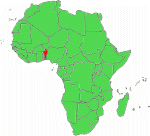| Republic of Benin Repúblique du Benin
Origin of Name named
after the ancient Nigerian kingdom of Benin
Location west Africa
Bordered By Togo, Burkina Faso, Niger, Nigeria

Area 43,484 sq mi
(112,622 sq km)
Greatest Distance E-W 202 mi (325 km)
Greatest Distance N-S 415 mi (668 km)
Highest Point Mont Sokbaro; 2,159 ft (659 m)
Lowest Point sea level
Natural Resources limestone, marble,
timber
Nationality Beninese
Population (2016) 10,741.458
Largest Cities Porto-Novo
Ethnic Groups Fon, Adja, Yoruba, Bariba,
Peulh, Ottamari, Yoa-Lokpa, Dendi
Religions Catholic, Muslim,
Vodoun, Protestant
Languages French (official), Fon,
Yoruba, tribal
Capital Porto-Novo
Form of Government republic
Present Constitution Adopted December 2,
1990
Chief of State and Head of Government President Patrice
Talon (since April 6, 2016)
Cabinet Council of Ministers
Legislature unicameral National Assembly
(Assemblee Nationale)
Judiciary Constitutional Court (Cour
Constitutionnelle), Supreme Court (Cour Supreme), High
Court of Justice
Local Administration 12 departments
Currency Cooperation
Financiere en Afrique Centrale Franc (XAF)
Per Capita Income $2,100
Industries textiles, food
processing, construction materials, cement
Agriculture cotton, corn, cassava
(manioc), yams, beans, palm oil, peanuts, cashews;
livestock
Export Commodities cotton,
cashews, shea butter, textiles, palm products, seafood
Import Commodities foodstuffs,
capital goods, petroleum products
Independence From France Achieved August 1, 1960
National Holiday National Day, August 1
Flag green symbolizes hope and
revival, yellow wealth, and red courage
SEE ALSO
Togo
Burkina
Faso
Niger
Nigeria
France
Questions or comments about this
page?
|
 SKC Films Library
SKC Films Library